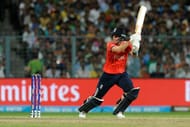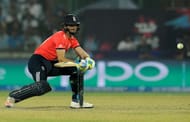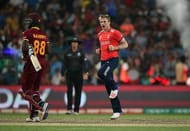West Indies became the first team to claim the World T20 twice as they beat England in the final in Kolkata. The tournament that began with a six from Martin Guptill and a New Zealand win ended with another six, this time from Carlos Brathwaite and the West Indies were crowned World champions in the T20 format.
There were plenty of memorable performances in the 2016 ICC World T20 but who were the best performers? Virat Kohli is an obvious pick as the Player of the tournament but who else makes the cut?
Here is the ICC World T20 2016 Team of the tournament:
Quinton de Kock
South Africa may have been dumped out of the tournament in the Super-10 stage but one of the few bright sparks from their tournament was the performance of opening batsman, Quinton de Kock. While one of the biggest talking points going into the tournament was whether AB de Villiers should open the batting, the performance of both Hashim Amla and de Kock ensured that even though AB didn’t, that didn’t matter too much.
Coming into the World T20, the wicketkeeper didn’t have a single T20I fifty to his name. In the first game, he not only got one but also equalled the South African record for the fastest T20I fifty that was held by AB. In the two games that followed he almost made it three fifties in three but unfortunately, wasn’t able to do so.
Although he didn’t fire in the final match, he was the epitome of consistency in the group stage and got his side off to a fast start and ensured the Proteas had the platform they needed, which they ultimately didn’t make the most of.
Usman Khawaja
The battle for the opening slot was between two Australians, Shane Watson and Usman Khawaja. Although Watson has a better average than Khawaja in the tournament, as an opener in two innings, he averaged only 17 and the bulk of his runs came when he batted at No.6. Although he was very good with the ball, with the team already having plenty of bowling options already, only the batting has been considered.
As a result, with a lowest score of 21 in the tournament and for providing Australia with a decent start in each game, Khawaja takes the opener's slot. Although he only got one fifty and wasn't able to kick on after the powerplay, he performed his role in the side expertly.
Although openers have the best opportunity of scoring big, with a flurry of big-hitters in the middle-order, all Australia wanted from the southpaw was to get them off to a flyer and that was something he certainly managed to do.
Virat Kohli
Nobody has scored more than 500 runs in a calendar year in T20Is, but in just the first three months of 2016, Virat Kohli not only achieved that but his tally for the year in T20I currently stands at 625 runs. What is more staggering is that those runs have come at an average of 125 and strike rate of almost 140.
In this tournament, he scored 273 runs in five innings, including three fifties at an average of 136.50, which rightly earned him the Player of the Series award, making it back-to-back such awards for the 27-year-old from Delhi.
Whether it was that fluent, unbeaten fifty against Pakistan at Kolkata, where all the other batsmen found it hard to score runs or that unbeaten 82 against Australia to seal that run chase and secure India's semi-final berth or his unbeaten 89 in the semi-final to help India post a good total, this tournament was one that saw him play some memorable knocks.
Joe Root
T20 was considered a format for the power hitters but almost since its inception, that statement has been proven to be a myth. While big hitters do thrive, it hasn’t signalled the end of the world for classical players, who rely on precision and timing rather than brute force.
Along with Kohli, the other player who exemplified that in this tournament was Joe Root. England’s No.3 was arguably the second-best batsman behind Root and he was the reason they got all the way to the final, instead of being on the verge of knocked out after the second game, against South Africa.
249 runs from 6 matches at an average of 49.8 is incredible and would be lauded a lot more if it wasn’t for Kohli’s super-human efforts in the tournament. Still, as England's go-to batsman, Root deserves his place in this side.
Jos Buttler
There was plenty of build-up before the start of the tournament about how Jos Buttler’s ability to access all areas of the pitch was going to be crucial in India. Although Buttler finished with nearly 200 runs at an average of 47.75 and strike rate of almost 160, his runs weren't all scoops and dinks and innovative shots.
Rather, what was impressive about Buttler’s knocks was how normal they were. He has the power to go over cow corner, but at the same time, also had the presence of mind to run quick singles and twos, rotate strike and attack bowlers who weren't a huge threat.
If Root rescued England from the brink of elimination, it was a Buttler special in the game against Sri Lanka that ensured that they reached the semi-finals. Until his arrival, England struggled on a track that wasn't spinning a great deal but once he was done, they had a match-winning score on their hands, one which they defended comfortably.
Andre Russell
It is not always easy to measure everything in terms of sheer numbers. Sometimes, you need to take a look beyond the numbers and look at what the player meant to the team and how crucial their performance or lack of it, adversely affects the team’s fortunes.
In that regard, Andre Russell has to be the tournament’s best all-rounder and one of the most important cogs in the Windies machine, even if he isn't talked about as much as Chris Gayle or Dwayne Bravo. Not only did Russell pick up 9 wickets, the most by a West Indian bowler, but the fact that bowled both with the new ball and at the death spoke for the confidence he had from the captain.
And when it mattered most, in the semi-final against India, who else but Russell, who stepped up, blitzed his way to a 43 and helped the Windies reach yet another World T20 final.
Mitchell Santner
Before the start of the tournament, many predicted that it would be the tournament for the spinners. But few would have predicted that the spinner with the most wickets would be a slow left arm bowler from New Zealand who had only played 5 T20Is coming into this tournament.
Yet, thanks to a combination of helpful surfaces and intelligent spin bowling, Mitchell Santner finished with 10 wickets from five matches at an average of 11.40 and an economy rate of just 6.27. What was more impressive was that he bowled in the powerplay and still managed to keep things tight.
While his wickets were certainly crucial, his runs in the opening game against India were the difference between a sub-par score on a turning track and a par score and that was what started New Zealand with a win that culminated in a semi-final place.
David Willey
For someone who is used to opening the batting and bowling for his previous county in England, it was certainly surprising to see David Willey bat so low for England. Still, with the ball in his hand, he was England's best bowler on surfaces that weren't exactly conducive to swing bowling.
Whether it was on turning tracks or flat ones, Willey managed to swing the ball and create trouble for the batsmen, who were largely more worries about the spinners. Not only did he pick up crucial wickets at the start for England, he also came back to bowl some at the end and wasn't too shabby there either.
In the final, where England had a below-par score, it was Willey's figures with the ball that kept them in the game until the end before Carlos Brathwaite smashed four successive sixes to help the Windies claim the title.
Ish Sodhi
This tournament was in many ways one that reaffirmed the belief that leg spinners are worth their weight in gold when it comes to T20s. While some might be expensive, their knack of picking up wickets makes them an invaluable asset.
Having said that, what was particularly interesting about Ish Sodhi wasn't so much that he picked up wickets (10 throughout the tournament), but that he picked them up at an economy rate of 6.1, which is incredible numbers for a leggie.
With an excellent leg spinner and intelligent variations through flight and drift, Sodhi managed to confuse batsmen throughout the tournament.
Samuel Badree
Samuel Badree has been the world's No.1 ranked T20I bowler for some time before he miraculously disappeared from the rankings altogether a short while before the tournament began. But thanks to his impressive performances in the World T20 and his part in helping the Windies becoming World champions, he is back on top again.
Badree isn't your usual run-of-the-mill leg spinner, he is someone who uses the variations in pace and length rather than turn to defeat the batsman. And despite bowling the bulk of his overs in the powerplay, his tournament economy rate of 5.39 and career T20I economy rate of 5.39 shows that he isn't someone who gives away a lot of runs and that his record in this tournament was no fluke.
Only two bowlers, both of whom played in the qualifiers, took more wickets than Badree’s 10. His ability to strangle the batsman and keep things quiet meant they had to take risks later in the innings, where against Russell and Bravo, two of the tournament's better death bowlers, they fell right into the trap set by Sammy.
Ashish Nehra
The battle for the final slot in this line-up was between two left-arm seamers. One was the youthful exhuberance of Bangladesh's Mustafizur Rahman, while the other was the wily experienced campaigner in Ashish Nehra. Although the former picked up more wickets, the fact that he only played three matches coupled with Nehra's consistency throughout the tournament means it is the Indian bowler who get the cut.
At 36, it is hard to imagine Nehra playing in another major ICC tournament. Then again, his participation in this one was unlikely as well, but not only did he turn out to be India's second-best performer after Virat Kohli, but also provided them with early wickets, a luxury that India didn't always have.
Bowling a majority of his overs at the start inside in the powerplay, the 36-year-old's economy rate of 5.94 is what sticks out like a sore thumb and that is why, he makes it into this line-up. For performing his role in the side and being so efficient and effective in the process.
Follow IPL Auction 2025 Live Updates, News & Biddings at Sportskeeda. Get the fastest updates on Mega-Auction and cricket news











